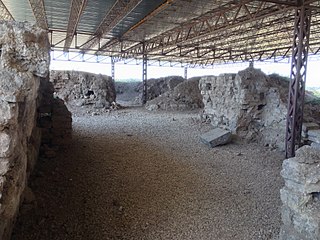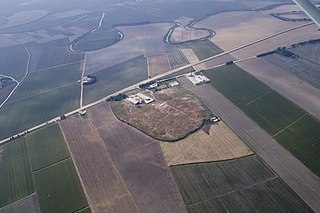
The Hurrians were a people who inhabited the Ancient Near East during the Bronze Age. They spoke the Hurrian language, and lived throughout northern Syria, upper Mesopotamia and southeastern Anatolia.

Mitanni, earlier called Ḫabigalbat in old Babylonian texts, c. 1600 BC; Hanigalbat or Hani-Rabbat in Assyrian records, or Naharin in Egyptian texts, was a Hurrian-speaking state in northern Syria and southeast Anatolia with Indo-Aryan linguistic and political influences. Since no histories, royal annals or chronicles have yet been found in its excavated sites, knowledge about Mitanni is sparse compared to the other powers in the area, and dependent on what its neighbours commented in their texts.

In archaeology a tell is an artificial topographical feature, a mound consisting of the accumulated and stratified debris of a succession of consecutive settlements at the same site, the refuse of generations of people who built and inhabited them and natural sediment. When transliterating a Hebrew toponym, the English spelling is tel, as opposed to conversion from Arabic, when the word is written 'tell'.
Shuttarna II was a king of the Hurrian kingdom of Mitanni in the early 14th century BC.

Alalakh is an ancient archaeological site approximately 20 kilometres (12 mi) northeast of Antakya in what is now Turkey's Hatay Province. It flourished, as an urban settlement, in the Middle and Late Bronze Age, c. 2000-1200 BC. The city contained palaces, temples, private houses and fortifications. The remains of Alalakh have formed an extensive mound covering around 22 hectares. In Late Bronze Age, Alalakh was the capital of the local kingdom of Mukiš.

Washukanni was the capital of the Hurrian kingdom of Mitanni, from around 1500 BC to the 13th century BC.

Mari was an ancient Semitic city-state in modern-day Syria. Its remains form a tell 11 kilometers north-west of Abu Kamal on the Euphrates River western bank, some 120 kilometers southeast of Deir ez-Zor. It flourished as a trade center and hegemonic state between 2900 BC and 1759 BC. The city was built in the middle of the Euphrates trade routes between Sumer in the south and the Eblaite kingdom and the Levant in the west.
Shuruppak, modern Tell Fara, was an ancient Sumerian city situated about 55 kilometres (35 mi) south of Nippur and 30 kilometers north of ancient Uruk on the banks of the Euphrates in Iraq's Al-Qādisiyyah Governorate. Shuruppak was dedicated to Ninlil, also called Sud, the goddess of grain and the air.

Tell Ta'yinat is a low-lying ancient tell on the east bank at the bend of the Orontes River where it flows through the Amuq valley, in the Hatay province of southeastern Turkey about 25 kilometers south east of Antakya, and lies near Tell Atchana, the site of the ancient city of Alalakh. Tell Ta'yinat has been proposed as the site of Alalaḫu, inhabited in late 3rd millennium BC, mentioned in Ebla's Palace G archive; and in later times as Kinalua, the capital city of an Iron Age Neo-Hittite kingdom. Among the findings are an Iron Age temple and several 1st millennium BC cuneiform tablets.
Šauštatar was the King of Mitanni in the fifteenth century BC. He significantly expanded the Mitanni Empire to include Assyria and Nuzi in the east to Alalakh and Kizzuwatna in the west. He was in conflict with Thutmose III competing for territory in Syria.

Tell Fekheriye is an ancient site in the Khabur river basin in al-Hasakah Governorate of northern Syria. It is securely identified as the site of Sikkan, attested since c. 2000 BC. While under an Assyrian governor c. 1000 BC it was called Sikani. Sikkan was part of the Syro-Hittite state of Bit Bahiani in the early 1st millennium BC. In the area, several mounds, called tells, can be found in close proximity: Tell Fekheriye, Ras al-Ayn, and 2.5 kilometers east of Tell Halaf, site of the Aramean and Neo-Assyrian city of Guzana. During the excavation, the Tell Fekheriye bilingual inscription was discovered at the site, which provides the source of information about Hadad-yith'i.
Artatama I was a king of the Hurrian kingdom of Mitanni in the late fifteenth century BC. His reign coincided with the reigns of Egyptian pharaohs Amenhotep II and Thutmose IV. He is believed to be the son of earlier Mitanni king Shaushtatar.

Terqa is the name of an ancient city discovered at the site of Tell Ashara on the banks of the middle Euphrates in Deir ez-Zor Governorate, Syria, approximately 80 kilometres (50 mi) from the modern border with Iraq and 64 kilometres (40 mi) north of the ancient site of Mari, Syria. Its name had become Sirqu by Neo-Assyrian times.
Tell es-Sweyhat is the name of a large archaeological site on the Euphrates River in northern Syria. It is located in Raqqa Governorate roughly 95 km northeast of Aleppo and 60 km south of Carchemish. Also, a Uruk site of Jebel Aruda and a Bronze Age site Tell Hadidi (Azu) are located just across the river.
Tuttul was an ancient Near East city. Tuttul is identified with the archaeological site of Tell Bi'a in Raqqa Governorate, Syria. Tell Bi'a is located near the modern city of Raqqa and at the confluence of the rivers Balikh and Euphrates.
Tall Munbāqa or Mumbaqat, the site of the Late Bronze Age city of Ekalte, is a 5,000-year-old town complex in northern Syria now lying in ruins. The ruins are located on a steep slope on the east bank of the upper course of the Euphrates. In the 3rd and 2nd millennium BC the city was an important city-state in the region. Due to the establishment of the Tabqa Dam at Al-Thawrah, 35 kilometers west of Raqqa, the city ruins are partially flooded today by Lake Assad. Situated high above the steep drop of the eastern shore, Tall Munbāqa is still preserved. The Bronze Age site of Tell Hadidi (Azu) lies 5 kilometers to the north. The city-god of Ekalte was Baʿlaka. There are known to have been four temples in the city, three on the high ground by the Euphrates and one at a city gate.
Tell Judaidah is an archaeological site in south-eastern Turkey, in the Hatay province. It is one of the largest excavated ancient sites in the Amuq valley, in the plain of Antioch. Settlement at this site ranges from the Neolithic through the Byzantine Period.
Jerablus Tahtani is a small tell on the right bank of the Euphrates River four kilometers south of Carchemish in present-day Syria.
Tell Hadidi, ancient Azu, is an ancient Near East archaeological site in Syria about 30 kilometers north of Emar and 5 kilometers north of Ekalte. It lies on the west bank of the Euphrates River on the opposite bank from Tell es-Sweyhat. It is thought to be a paired city with Tell es-Sweyhat controlling a Euphrates river crossing. There are prominent hollow ways between the site and Tell es-Sweyhat, Tell Othman, and Tell Jouweif. The site was occupied from the Early Bronze Age period to the Late Bronze Age and again to a lesser extent in Roman times. It was one of several rescue excavations sparked by the construction of the Tabqa Dam and the resulting Lake Assad. The town's primary god was Dagan.
Kurd Qaburstan, is an ancient Near East archaeological site in the Erbil Governorate, in the Kurdistan Region of Iraq, 22 kilometers southwest of Erbil. It is considered one of the most important archaeological sites in the region. The site is strategically located between the Upper and Lower Zab rivers. The modern village of Yedi Kizlar is adjacent to and covers a portion of the southeastern lower town. The site is primarily a single-period site dating to the early 2nd millennium BC, the Middle Bronze Age. There is also a compact Late Bronze Age occupation on the high mound. Kurd Qaburstan has been proposed as the location of the ancient city of Qabra. The site is located near Tell Halawa, Tell Aliawa, Tell Baqrta, and Qasr Shemamok (Kilizi), other prominent sites on the Erbil plain.









